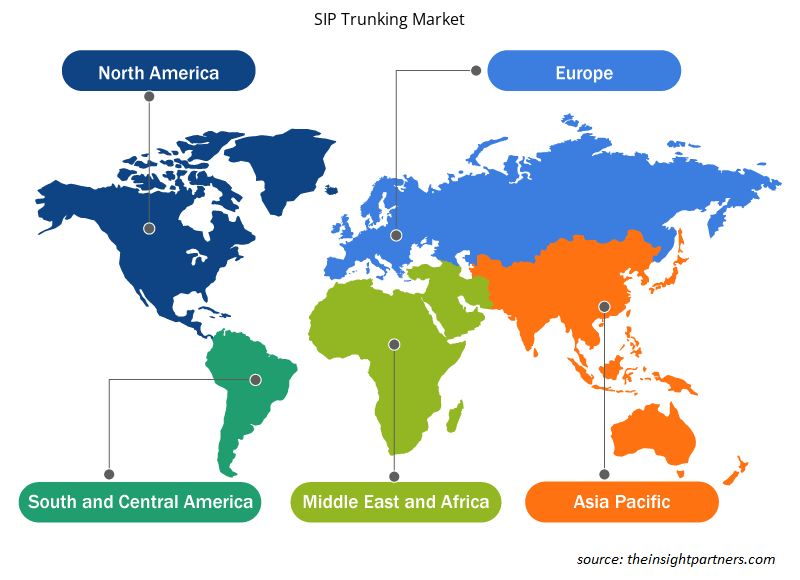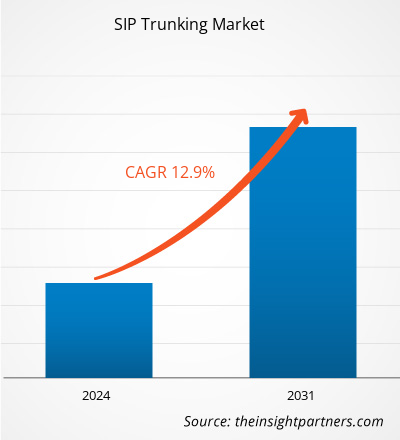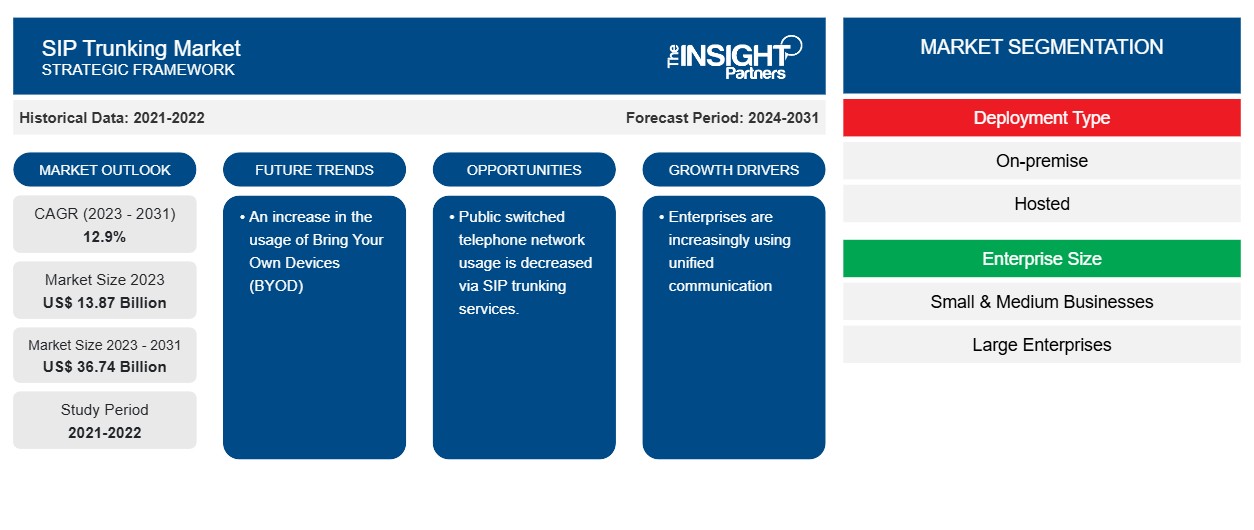La taille du marché des liaisons SIP devrait atteindre 36,74 milliards USD d'ici 2031, contre 13,87 milliards USD en 2023. Le marché devrait enregistrer un TCAC de 12,9 % en 2023-2031. L'augmentation de l'utilisation des appareils BYOD (Bring Your Own Devices) à l'échelle mondiale devrait rester une tendance clé du marché des liaisons SIP.
Analyse du marché des liaisons SIP
Le besoin de trunking SIP est stimulé par l'utilisation croissante des solutions de communication unifiée (UC) dans les contextes d'entreprise, une diminution notable des dépenses téléphoniques et un retour sur investissement rapide (ROI) rendu possible par les services de trunking. La demande de services de trunking SIP a augmenté car ils ont supprimé la nécessité pour les entreprises d'acheter des passerelles de réseau téléphonique public commuté (PSTN) supplémentaires. La demande de trunking SIP est stimulée par la nécessité d'augmenter la fiabilité du service grâce à l'ajout de services VoIP et à la fourniture de différentes capacités de streaming numérique. Néanmoins, les préoccupations croissantes des utilisateurs finaux en matière de sécurité entravent l'expansion de l'activité de trunking SIP. D'autre part, l'utilisation croissante du trunking SIP dans les secteurs verticaux, notamment la santé, l'hôtellerie et la restauration, devrait offrir un certain nombre d'opportunités de croissance du marché du trunking SIP.
Aperçu du marché des liaisons SIP
Le service d'un fournisseur de services de communication, connu sous le nom de « liaison SIP », utilise le protocole d'initiation de session (SIP) pour fournir un accès voix sur IP (VoIP) entre un réseau téléphonique public commuté (PSTN) et un système téléphonique sur site. Le service de liaison SIP est utilisé pour l'établissement, l'administration, la gestion et la suppression des appels. Les services de liaison SIP hébergés et sur site constituent les deux principales catégories. Avec un autocommutateur privé (PBX) hébergé, les utilisateurs peuvent utiliser les fonctions du PBX telles que la messagerie vocale, le transfert d'appel, le standard automatique et la distribution automatique des appels sans avoir à gérer ou à posséder tout le matériel nécessaire sur site.
Personnalisez ce rapport en fonction de vos besoins
Vous bénéficierez d'une personnalisation gratuite de n'importe quel rapport, y compris de certaines parties de ce rapport, d'une analyse au niveau des pays, d'un pack de données Excel, ainsi que d'offres et de remises exceptionnelles pour les start-ups et les universités.
-
Obtenez les principales tendances clés du marché de ce rapport.Cet échantillon GRATUIT comprendra une analyse de données, allant des tendances du marché aux estimations et prévisions.
Facteurs moteurs et opportunités du marché des liaisons SIP
Les entreprises utilisent de plus en plus la communication unifiée.
Le fournisseur de services de téléphonie Internet (ITSP) propose un service appelé trunk SIP qui facilite la communication entre le fournisseur de services de téléphonie Internet et le central téléphonique privé (PBX) de l'entreprise. Le trunk SIP permet aux entreprises d'offrir une connectivité au réseau téléphonique public commuté (PSTN) à l'aide d'un réseau IP, tel qu'Internet, contrairement aux services de téléphonie traditionnels, qui impliquent qu'un fournisseur de services livre des faisceaux de câbles physiques à une entreprise. Cela incite les entreprises à mettre en œuvre des solutions de communication unifiée (UC) afin de réduire les dépenses téléphoniques et d'augmenter le retour sur investissement, à l'aide du trunking SIP. Le marché mondial du trunking SIP est en pleine expansion en raison de ce facteur.ITSP) offers a service called SIP trunk that facilitates communication between the ITSP and the corporate Private Branch Exchange (PBX). SIP trunk enables businesses to offer Public Switched Telephone Network (PSTN) connectivity using an IP network, such as the Internet, in contrast to traditional telephony services, which involve a service provider delivering bundles of physical wires to a business. This is motivating businesses to implement Unified Communication (UC) solutions in order to save
L'utilisation du réseau téléphonique public commuté est réduite grâce aux services de liaison SIP.
Les périphériques de service de liaison SIP étant souvent moins chers par ligne que le même système de passerelle PSTN traditionnel, l'installation d'un tel périphérique dans le réseau de communication d'une organisation offre un moyen moins coûteux d'ajouter de nouvelles lignes. Le marché des services de liaison SIP optimise considérablement l'utilisation de la bande passante, augmentant l'efficacité du réseau en fournissant à la fois la voix et les données sur la même liaison. Le marché des services de liaison SIP est stimulé par la capacité d'une entreprise à effectuer des appels internationaux au prix d'un appel local en utilisant le service de liaison SIP. Ainsi, l'utilisation du réseau téléphonique public commuté est réduite via la liaison SIP et devrait présenter de nouvelles opportunités pour les acteurs du marché de la liaison SIP au cours de la période de prévision.PSTN gateway system, installing one in an organization's communication network provides a less expensive route for adding new lines. The SIP trunking services market greatly optimizes bandwidth use, increasing network efficiency by delivering both voice and data over the same link. The market for SIP trunk services is being driven by the ability of a company to make international calls for the cost of a local call by using the SIP trunking service. Thus, public switched telephone network usage is decreased via SIP trunking is anticipated to present new opportunities for the SIP trunking market players during the forecast period.
Analyse de segmentation du rapport sur le marché des liaisons SIP
Les segments clés qui ont contribué à l’élaboration de l’analyse du marché des liaisons SIP sont le type de déploiement, la taille de l’entreprise et l’utilisateur final.
- En fonction du type de déploiement, le marché des liaisons SIP est divisé en deux segments : sur site et dans le cloud. Le segment du cloud détenait une part de marché plus importante en 2023.
- En fonction de la taille de l’entreprise, le marché est segmenté en petites et moyennes entreprises et en grandes entreprises.
- En fonction des utilisateurs finaux, le marché des liaisons SIP est segmenté en éducation, informatique et télécommunications, vente au détail, médias et divertissement, BFSI, soins de santé et gouvernement.
Analyse des parts de marché des liaisons SIP par zone géographique
La portée géographique du rapport sur le marché des liaisons SIP est principalement divisée en cinq régions : Amérique du Nord, Asie-Pacifique, Europe, Moyen-Orient et Afrique, et Amérique du Sud/Amérique du Sud et centrale. En termes de revenus, l'Amérique du Nord représentait la plus grande part de marché des liaisons SIP. Ces marchés inexplorés offrent d'énormes possibilités aux fournisseurs de services SIP. Les services de liaisons SIP sont adoptés par les opérateurs de gros et les entreprises de ces régions comme un substitut fiable et abordable aux systèmes téléphoniques traditionnels afin d'obtenir une connectivité fiable au sein des organisations, quelle que soit la géographie.
Aperçu régional du marché des liaisons SIP
Les tendances et facteurs régionaux influençant le marché des liaisons SIP tout au long de la période de prévision ont été expliqués en détail par les analystes d’Insight Partners. Cette section traite également des segments et de la géographie du marché des liaisons SIP en Amérique du Nord, en Europe, en Asie-Pacifique, au Moyen-Orient et en Afrique, ainsi qu’en Amérique du Sud et en Amérique centrale.

- Obtenez les données régionales spécifiques au marché des liaisons SIP
Portée du rapport sur le marché des liaisons SIP
| Attribut de rapport | Détails |
|---|---|
| Taille du marché en 2023 | 13,87 milliards de dollars américains |
| Taille du marché d'ici 2031 | 36,74 milliards de dollars américains |
| Taux de croissance annuel composé mondial (2023-2031) | 12,9% |
| Données historiques | 2021-2022 |
| Période de prévision | 2024-2031 |
| Segments couverts |
Par type de déploiement
|
| Régions et pays couverts |
Amérique du Nord
|
| Leaders du marché et profils d'entreprises clés |
|
Densité des acteurs du marché : comprendre son impact sur la dynamique des entreprises
Le marché des liaisons SIP connaît une croissance rapide, tirée par la demande croissante des utilisateurs finaux en raison de facteurs tels que l'évolution des préférences des consommateurs, les avancées technologiques et une plus grande sensibilisation aux avantages du produit. À mesure que la demande augmente, les entreprises élargissent leurs offres, innovent pour répondre aux besoins des consommateurs et capitalisent sur les tendances émergentes, ce qui alimente davantage la croissance du marché.
La densité des acteurs du marché fait référence à la répartition des entreprises ou des sociétés opérant sur un marché ou un secteur particulier. Elle indique le nombre de concurrents (acteurs du marché) présents sur un marché donné par rapport à sa taille ou à sa valeur marchande totale.
Les principales entreprises opérant sur le marché des liaisons SIP sont :
- Lien du siècle
- AT&T
- Bande passante
- Mitel
- Net2Phone
- GTT Communications
Avis de non-responsabilité : les sociétés répertoriées ci-dessus ne sont pas classées dans un ordre particulier.

- Obtenez un aperçu des principaux acteurs du marché des liaisons SIP
Actualités et développements récents du marché des liaisons SIP
Le marché des liaisons SIP est évalué en collectant des données qualitatives et quantitatives après des recherches primaires et secondaires, qui comprennent d'importantes publications d'entreprise, des données d'association et des bases de données. Voici une liste des évolutions du marché des troubles de la parole et du langage et des stratégies :
- En août 2021, 8x8, Inc. a signé un nouvel accord de distribution avec SYNNEX Corporation pour donner accès à 8x8 XCaaS à la communauté de partenaires de SYNNEX composée de revendeurs à valeur ajoutée (VAR) traditionnels, d'intégrateurs de systèmes et de fournisseurs de services gérés (MSP).
(Source : 8x8, Inc, communiqué de presse)
Rapport sur la couverture et les livrables du marché des liaisons SIP
Le rapport « Taille et prévisions du marché des liaisons SIP (2021-2031) » fournit une analyse détaillée du marché couvrant les domaines ci-dessous :
- Taille du marché et prévisions aux niveaux mondial, régional et national pour tous les segments de marché clés couverts par le périmètre
- Dynamique du marché, comme les facteurs moteurs, les contraintes et les opportunités clés
- Principales tendances futures
- Analyse détaillée des cinq forces de PEST/Porter et SWOT
- Analyse du marché mondial et régional couvrant les principales tendances du marché, les principaux acteurs, les réglementations et les développements récents du marché
- Analyse du paysage industriel et de la concurrence couvrant la concentration du marché, l'analyse de la carte thermique, les principaux acteurs et les développements récents
- Profils d'entreprise détaillés
- Analyse historique (2 ans), année de base, prévision (7 ans) avec TCAC
- Analyse PEST et SWOT
- Taille du marché Valeur / Volume - Mondial, Régional, Pays
- Industrie et paysage concurrentiel
- Ensemble de données Excel
Rapports récents
Témoignages
Raison d'acheter
- Prise de décision éclairée
- Compréhension de la dynamique du marché
- Analyse concurrentielle
- Connaissances clients
- Prévisions de marché
- Atténuation des risques
- Planification stratégique
- Justification des investissements
- Identification des marchés émergents
- Amélioration des stratégies marketing
- Amélioration de l'efficacité opérationnelle
- Alignement sur les tendances réglementaires























 Obtenez un échantillon gratuit pour - Marché des liaisons SIP
Obtenez un échantillon gratuit pour - Marché des liaisons SIP